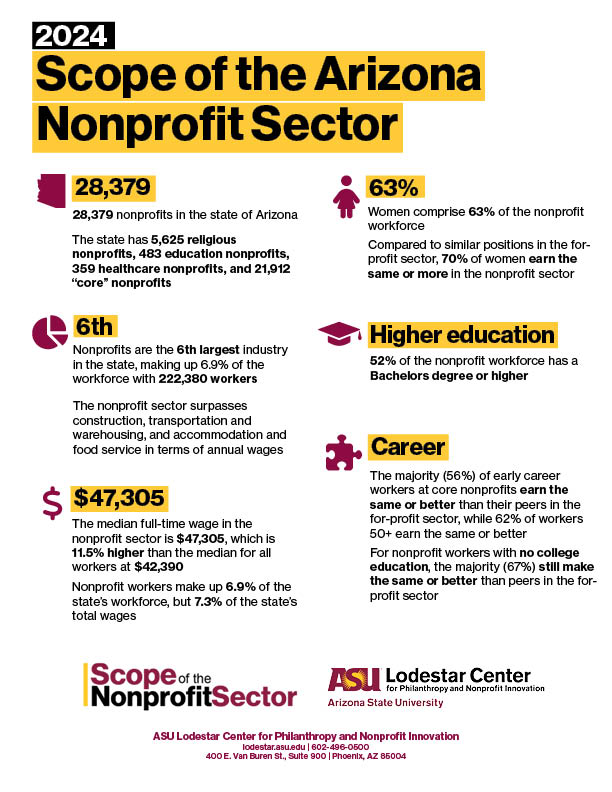
Nonprofits now comprise the 6th largest industry in Arizona by economic impact, ASU research project finds
ASU Lodestar Center’s “Scope of the Sector” data platform analyzed the state’s 28,379 nonprofits to uncover surprising findings on economic impact, employment and wages
March 20, 2024 — Arizona’s nonprofit sector spans from tiny groups supporting local swim clubs to giant healthcare organizations with billions of dollars in annual revenue. A research platform from Arizona State University’s Lodestar Center for Philanthropy and Nonprofit Innovation has quantified the full size and true impact of this often-overlooked pillar of Arizona’s economy.
“Scope of the Arizona Nonprofit Sector” blends data from the Internal Revenue Service, the Census Bureau and IPUMS USA to paint a detailed picture of the varied nonprofit landscape. Beyond simply reporting the number and location of Arizona nonprofits, this novel approach to nonprofit data allows ASU Lodestar Center researchers to answer such questions as:
- What is nonprofits’ economic impact compared to other sectors and industries?
- How many people do nonprofits employ, and how much do their workers make?
- Do nonprofit workers make less than comparable for-profit peers?
- Does the nonprofit sector have a gender wage gap?
Those and other questions are answered on a new website platform, populated with interactive dashboards, visualizations and digestible research papers. The website will continue to evolve with new dashboards and findings over time, helping funders, practitioners and researchers better understand the nonprofit sector and address its needs.
“The nonprofit and philanthropic sector is both the best understood and least understood of all attributes of our society,” said Dr. Robert Ashcraft, Executive Director of the ASU Lodestar Center and Saguaro Professor of Civic Enterprise. “Most every individual and family is engaged with, or have benefitted from, nonprofits in their daily lives. Yet, ongoing myths often drown out actual facts, as revealed through our 'Scope' data platform, that communicates essential sector characteristics as a key driver of the social economy of Arizona and the United States,” Ashcraft added.

Key findings about this hidden driver of Arizona’s economy include the following:
Size and scope
Arizona has 28,379 nonprofit organizations, according to IRS data from February 2024.
Maricopa County accounts for 16,610 nonprofits, about 59% of the total organizations. The county with the second greatest number of nonprofits is Pima County, which is home to one-sixth of the nonprofits in the state (4,474). Nonprofit distribution closely correlates with county population in Arizona.
The state has 5,625 religious nonprofits, 483 education nonprofits, 359 healthcare nonprofits, and 21,912 “core” nonprofits. Core includes all other organization types, from animal welfare to youth services.
Economic impact
Arizona’s nonprofit sector, if treated as an industry unto itself, would rank as the sixth largest in the state, surpassing construction, transportation and warehousing, and accommodation and food service in terms of annual wages. Arizona’s nonprofits reported $58.2 billion in income in 2022.
The nonprofit industry employs 222,380 workers, who earn 7.3 percent of the total wages paid in the state. That’s about 1 in 14 workers in Arizona, and it is nearly as many as in manufacturing (226,164), construction (233,576), and accommodation and food services (245,396).
Contrary to the image of nonprofit work entailing low pay, the median wage for nonprofit workers exceeds the state median wage. The median nonprofit wage of $47,305 is 11.6 percent greater than the overall state median wage ($42,390).
Comparative pay
Do nonprofit workers pay a price for working at a charitable organization organized for the public interest? To put it in dollars and cents terms, are nonprofit workers paid more or less than their peers in the for-profit and government sectors?
According to Census Bureau data and ASU Lodestar Center analysis, 58 percent of workers in the “core” nonprofit sector make just as much or more than their peers in the for-profit and government sectors. In nonprofit healthcare, it’s 77 percent. Across all nonprofit subsectors, 35% are paid less, 29% are paid similarly, and 36% are paid more – meaning 65% do just as well or better than for-profit peers.
In Maricopa County, the median nonprofit wage is $51,288. That aligns closely with the county’s living wage figure of $51,380, according to MIT. Looking at Arizona’s other counties, Coconino County – home to Flagstaff and other northern cities – has a large disparity. The median nonprofit wage there is $44,510, but the living wage is nearly $53,000, revealing a potential barrier for nonprofit work in Coconino County.
When looking through the lens of educational attainment, the nonprofit sector offers favorable wages to those with lower levels of formal education, with 67 percent of workers with no college education earning at least as much as their peers outside the nonprofit sector. Nonprofit healthcare organizations pay these workers particularly well: 46% of them earn more than their for-profit peers.
Women in nonprofits
Women comprise 63% of the nonprofit workforce, and they do well compared to other sectors. We found that 70 percent of women in nonprofits earn at least as much as their peers in the for-profit sector, compared to 56 percent of men.
For more findings on nonprofits in Arizona, visit the Scope of the Arizona Nonprofit Sector website. This platform will be continually updated with new research and data to continue telling the sector’s story.
Through research, education, technical assistance and convenings, the ASU Lodestar Center for Philanthropy and Nonprofit Innovation focuses on advancing nonprofit leaders and philanthropists to solve problems, to realize a community’s highest aspirations and to accelerate social impact.

